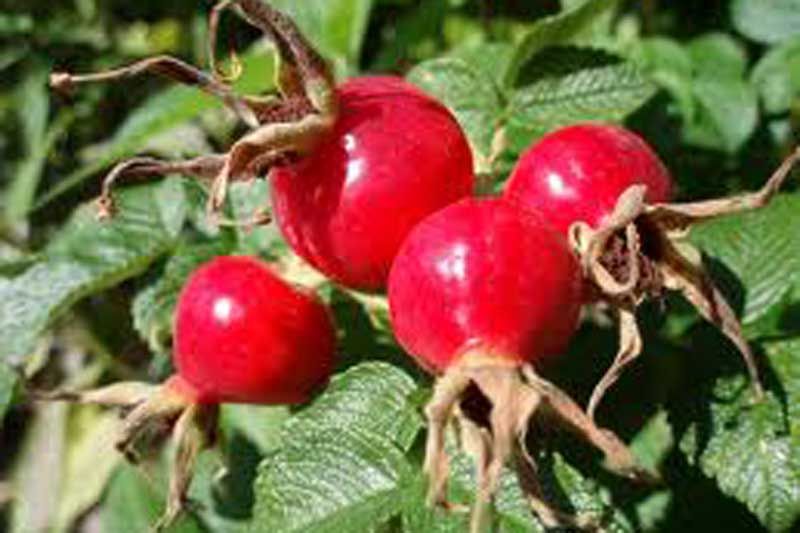Lorraine Julien | Sep 25, 2013
By Lorraine Julien
Did you know that raspberries, blackberries, dewberries and apples all come from a closely related species in the rose family? They all belong to the Rosaceae family. Some of them have flowers that resemble roses and the thorn-covered berry canes arch towards the ground much like wild or climbing roses. For many years I thought that what were really rose hips, in fact were actually wild red raspberries.
Rose hips - Rose hips are actually the small red bottle-shaped fruit that is left after the rose flower dies. This happens with both wild and domestic roses. The domestic Rugosa rose has some of the best and most prolific hips. Rose hips are a great source of Vitamin C and can be harvested and prepared as a natural way to boost intake of this important vitamin. Unfortunately, domestic rose hips are usually overlooked as gardeners trim the dead flowers before the rose hip can form.
All roses are edible but we are most familiar with the rose’s tasty cousins – fruits such as plums, apples, blackberries and raspberries – all of which have a rose-like flower before forming fruits. A rose hip is simply the fruit of the rose plant. Unlike their popular cousins, rose hips don’t have much flesh beneath their skins. Instead, they are filled with tiny seeds covered with silky hairs. The skin of the hip, which tastes somewhat like an apple, is where most of the food value and nutrition is stored.
Rose hips look like tiny crab apples and have a sweet tartness. Look for them in late summer or early fall – just about now. Harvesting rose hips is quite simple – they should be removed from the stem of the rose plant after the first frost when they are the sweetest. When harvested, hips should be firm with a little “give” in texture, and bright red or orange in colour. If any of the hips are shrivelled, do not collect them. Birds and animals can still enjoy them.
Once harvested, the hips should be prepared as soon as possible. They need to be cut open (use scissors to cut them in half and remove the seeds) and then rinse. Drain them thoroughly and let them air dry to remove any additional moisture. To dry, lay them out evenly with some space between them. Place them in a dark, dry, warm location until they shrivel up, much like raisins. Once dry, the hips can be dried or frozen.
Although rose hips can be eaten raw (if you avoid the tiny hairs inside), they can be dried, ground and used in tea, and/or cooked to make jam, jelly, syrup, marmalade, wine, and also as a healthy treat for pets. There are a lot of recipes on the internet. Dried, powdered rose hips are sometimes fed to horses to improve coat condition and new hoof growth.
Compared to oranges, rose hips contain 25% more iron, 20 to 40% more Vitamin C (depending on the variety), 25 times the Vitamin A and 28% more calcium. In addition, they are rich in bioflavonoids, pectin, Vitamin E, selenium, manganese and the B-complex vitamins. You can see that they are a real store house of nutrition.
Rose hips can be found in dried form in most health food stores, and even some grocery stores, but why not gather your own?
Acorns – We’ve had a bumper crop of acorns this year. Our home has been bombarded with loads of these things; even the eaves troughs were full of them. It’s been especially noisy in the screened porch where the roof isn’t insulated! Perhaps the abundance of acorns is a result of the long, rainy spring or, heaven forbid, the forerunner of a cold snowy winter; but in any case, deer, squirrels, chipmunks, turkeys and other wild creatures are in for a good supply of food this year. Even the beech nut tree was loaded with nuts and the ground underneath is covered in empty shells where the birds and squirrels have been feasting.
I came across an ad on the internet where someone was selling acorns this year for $1.50 a pound plus shipping. Acorns can be fed to animals but are also used in arts and crafts. Humans can also eat them if they are prepared properly and the tannins are removed (the tannins have a bitter taste). There are certainly many preparation methods available on the internet. Somehow acorns do not appeal to me as a food! One fellow said on the internet that he’d sooner the deer eat the acorns and then he would eat the deer!
Please feel free to report any observations to Lorraine Julien at This email address is being protected from spambots. You need JavaScript enabled to view it. or Steve Blight at This email address is being protected from spambots. You need JavaScript enabled to view it.
More Stories
- No Winner Yet in Catch The Ace But Fundraising Target Met
- South Frontenac Food Bank Opens Second Location in Battersea
- Sharbot Lake Pentecostal Church Anniversary - 1925-2025
- Frontenac Holistic Health Fair - September 20 At Storrington Centre
- Odd Year For Real Estate - But Sales Are Steady Year Over Year
- 193rd Kingston Fall Fair
- Kim Phuc - the Napalm Girl - To Visit Flinton In November
- South Frontenac Council - September 2
- Sticker Shock - EV Charging Station To Cost North Frontenac Township
- 30th Anniversary Verona Car Show

